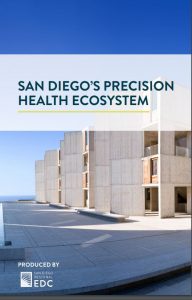Small businesses are the backbone of the San Diego economy, representing 98 percent of local businesses and employing roughly 59 percent of the workforce. According to a new study by San Diego Regional EDC, in partnership with the San Diego & Imperial Small Business Development Center, small businesses are one of the primary drivers of local economic growth, with 41 percent of the region’s small businesses intending to hire more employees in the next two years.
Based on a survey of more than 500 respondents, “An In-Depth Look at San Diego’s Small Business Ecosystem” uncovers insight about the region’s small businesses – those with fewer than 100 employees – and quantifies the number of firms, workforce, demographic and industry breakdown, business outlook and more across San Diego and Imperial counties.
The study found 36 percent of small businesses are women-owned, 20 percent are minority-owned, and 10 percent are veteran-owned.
“This study helps reinforce what we already know: San Diego’s small businesses are the cornerstone of our economy, employing nearly 700,000 San Diegans and driving innovation across the world,” said Kirby Brady, Research Director, San Diego Regional EDC.
Encompassing industries from healthcare, finance, food and beverage, education, construction and real estate, San Diego’s small businesses are driving the local economy – representing two-thirds of current regional employment.
KEY FINDINGS
- Small businesses employ 697,000 workers, making up 59 percent of San Diego’s total workforce.
- 27 percent of the region’s workers are in businesses with fewer than 20 employees; while more than 64 percent of firms employ fewer than five people.
- 69 percent of small businesses reported financial growth in the past two years.
- 59 percent of the region’s small businesses have local customers.
- Of firms surveyed, roughly 43 percent expect to grow in terms of workforce and 81 percent expect to grow in terms of financial performance.
- The majority of companies who have been operating less than two years generate less than $100K in annual revenue, while more than half of established companies (10 years or longer) generate more than $1M in revenue annually.
- Small business growth challenges:
- Eighty-five percent of locally-serving small business said ‘sales and new business’ is a challenge, including 25 percent who said it is the most significant challenge.
- Fourteen percent of small businesses said that ‘financial stability and cash flow’ is the most significant challenge.
“In order to better serve the needs of our small businesses and entrepreneurs, it’s important that we understand their perceptions and experiences,” said Danny Fitzgerald, Associate Regional Director of San Diego & Imperial SBDC Network. “This study will enable us to create new and enhance existing programming to support small business growth across the region.”
Furthermore, with a commitment to lifting up San Diego small businesses, EDC has launched an Inclusive Growth initiative in order to develop measurable targets and actionable recommendations to promote small business growth, talent development and affordability.
“The SBDC has become our trusted ‘go to’ resource for just about everything. They have connected us to the vast networks in San Diego that has brought us new customers and important industry connections. We wouldn’t be where we are today without them,” said Nic Halverson, Founder/CEO of Waitz App.
The report was produced by San Diego Regional EDC, with support from the San Diego & Imperial Small Business Development Center.
Read the full study here
For more research from San Diego Regional EDC, visit sandiegobusiness.org/about-the-region.




